|
|
|
| |
| |
|
Secondary Vaping and Marijuana- October 2019
|
![Secondary Vaping and Marijuana- October 2019]() |
|
|
|
|
|
 | October 2019
Secondary Snapshot
Vaping & Marijuana
|
|
|
The current legal smoking age in B.C. is 19. It is against the law to sell, give or provide any tobacco and/or vapour products to anyone under the age of 19. In terms of Cannabis, only persons over 18 can legally possess up to 30 grams of legal dried cannabis or equivalent.
|
|
|
|
|
|
|
Vaping is the act of inhaling and exhaling an aerosol produced by a vaping product, such as an electronic cigarette. Vaping doesn‘t require burning like cigarette smoking. The device heats a liquid into a vapour, which then turns into aerosol. This vapour is often flavoured and can contain nicotine.
|
|
|
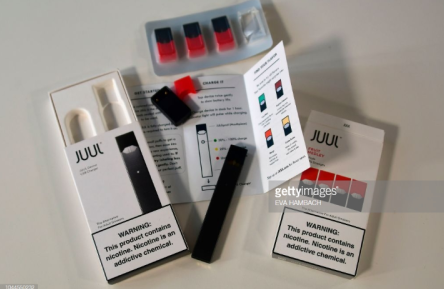
| Vaping devices are usually battery-powered.They may come with removable parts. Vaping products have many names, including:
mods
vapes
sub-ohms
vape pens
e-hookahs
tank systems
electronic cigarettes
e-cigarettes
electronic nicotine delivery systems (ENDS).
|
|
|
|
They may also be known by various brand names. The most common vape product for youth is JUUL
(72% of e-cig market). A single Juulpod commonly contains 40ml of nicotine (similar to a pack of cigarettes) and there are also 23 mg pods. Just like cigarettes, there is a great variation in terms of consumption rates
|
| |
|
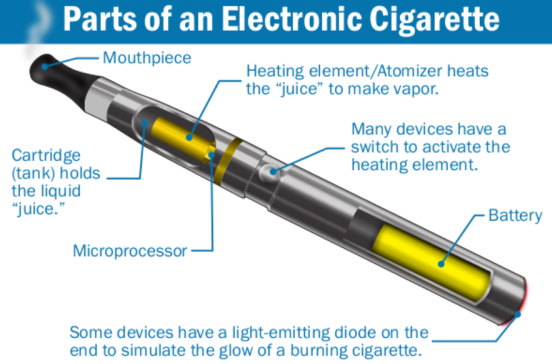
| Most vaping devices consist of a:
- battery
- mouthpiece
- heating element
- chamber, such as a tank or reservoir to contain a liquid solution
Most vaping devices use electrical power from a battery to heat a liquid solution. The heat causes the solution to become vaporized. The vapour then condenses into an aerosol, which is breathed in by the user through the mouthpiece.
|
|
|
Vaping devices are available in many shapes and sizes. Some are small and look like USB drives or pens, while others are much larger.
There are two kinds of vaping devices: open, which means they can be refilled, closed, which means either the whole product, or the part that holds the vaping substances, can‘t be refilled.
|
|
|
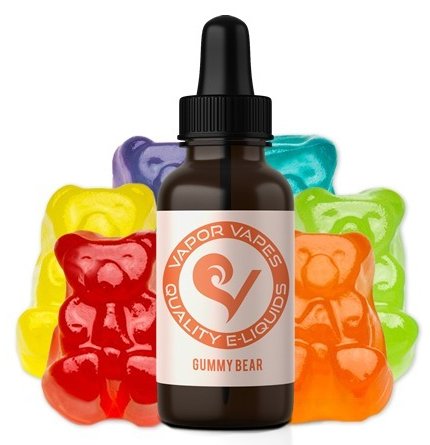 |
VAPING LIQUIDS AND SUBSTANCES
Most vaping substances available for sale:
- are flavoured
- contain nicotine
- are liquids, but some are offered as wax or herbs
In vaping liquids, nicotine and/or flavouring compounds are dissolved in a liquid mixture. This mixture is typically propylene glycol and/or glycerol (vegetable glycerin).
In the vaping substances that contain nicotine, the level of nicotine can vary widely. Some mixtures have:
- very low levels of nicotine
- more nicotine than in a typical tobacco cigarette.
|
|
|
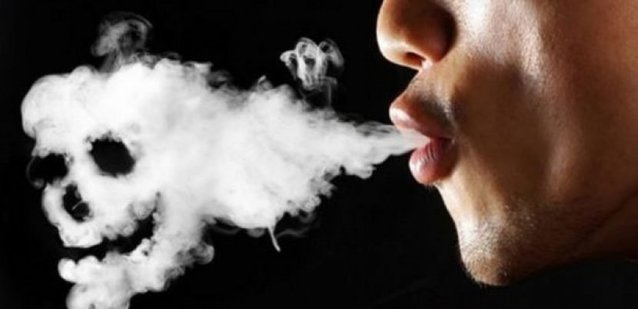 |
CONTENTS OF VAPING VAPOUR
Vaping products produce an aerosol that may contain dozens of chemicals. The ingredients typically found in vaping liquids are also found in the aerosol. They include:
- glycerol
- flavours
- propylene glycol
- nicotine (possibly)
(Government of Canada, 2018)
|
|
|
|
NICOTINE AND ITS EFFECTS
Nicotine is only one of more than 4,000 chemicals in tobacco, but it is the major component that acts on the brain. The lungs readily absorb nicotine from the smoke of cigarettes, cigars, or pipes. The tissues of the mouth can also absorb nicotine when a person smokes cigars or pipes, or chews tobacco.
Nicotine reaches the brain within seconds and has a direct effect on the body for up to 30 minutes. When a person uses tobacco regularly, the levels of nicotine accumulate in the body during the day and persist overnight, exposing the person to the effects of nicotine for 24 hours.
|
| |
|
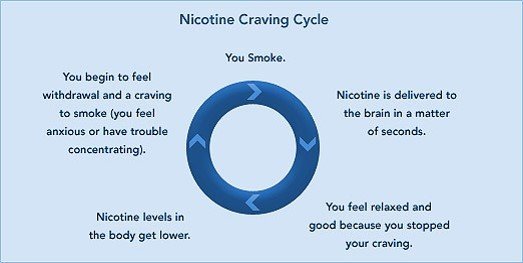
| In the body, nicotine acts as both a central nervous system stimulant and sedative. The person immediately feels the stimulant effect and pleasurable sensation. It increases alertness, relaxes muscles, improves memory and attention, and decreases irritability. The stimulant effect causes a sudden increase in blood pressure, breathing rate, and heart rate. The central nervous system stimulation is followed by depression and fatigue, causing the person to want another cigarette.
|
|
|
Nicotine is one of the most addictive substances. Some people show early signs of addiction within days to weeks after starting to smoke. Repeated tobacco use causes a need for increasingly large amounts of nicotine to feel the same effect (tolerance) and withdrawal symptoms if the person tries to quit.
|
|
|
|
 | Smoking affects a person's appearance by causing bad breath, yellow teeth and fingernails, and wrinkles. It also affects a person's fitness and stamina level. Tobacco also leads to serious health problems, including:
- Long-term (chronic) cough, shortness of breath, and wheezing.
- Increased risk for heart disease, lung and other cancers, stroke, and emphysema.
- Increased risk for upper respiratory infections like the common cold, the flu, and sinusitis.
|
| |
|
|
|
MYTH: The vapour exhaled from a vaping device is just water?
Vaping products do not produce smoke or steam, but rather an aerosol consisting of fine particles, containing varying amounts of propylene glycol, glycerin, flavourings and other chemicals. Some of these have been linked to cancer, respiratory and heart disease.
MYTH: E-juice does not contain nicotine.
Tests performed by Health Canada found that about half of e-juices that were labelled “nicotine free” actually contained nicotine.
MYTH: Vapour products are harmless.
Vapour products are marketed as a harmless alternative to smoking. However, Health Canada states that there are health risks linked to chemicals found in vapour products and long term effects of vaping are still unknown. Even small amounts of e-juice can be poisonous to a young child if ingested and can be toxic if spilled on the skin.
FACT: It is illegal to purchase vapour products for minors.
Vapour devices and liquids are readily available to buy on the internet or at local retailers. It is AGAINST THE LAW to sell, give or provide any vapour products to someone under the age of 19. If you suspect someone is providing vapour products to minors, please contact Island Health Tobacco And Vapour Prevention and Control at 250-519-3426.
|
|
|
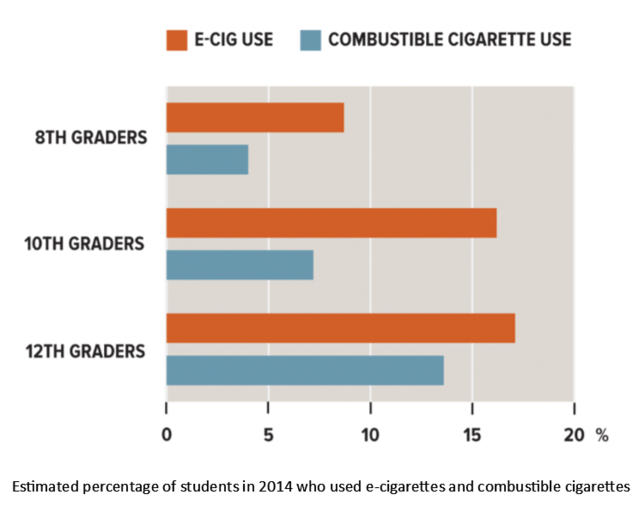
|
FACT: More youth aged 15-19 have tried vaping than smoking tobacco.
Smoking rates have steadily declined in Canada and BC, but vaping among youth is on the rise. About one in four Canadian youth aged 15 to 19 years report having tried an electronic cigarette.
FACT: Vapour devices can be used to inhale illicit substances.
Newer generations of vapour devices can be altered for use with cannabis or its components (THC, hash oil) or other substances.
|
|
|
FACT: Youth vaping may lead to tobacco use.
Nicotine is a highly addictive substance. Youth are more vulnerable to addiction because their brains are still developing. There are concerns that adolescent vapour product users may begin smoking tobacco products. A new study by the University of Waterloo found that teenagers who vape have double the risk of smoking tobacco cigarettes.
|
|
|
|
|
|
|
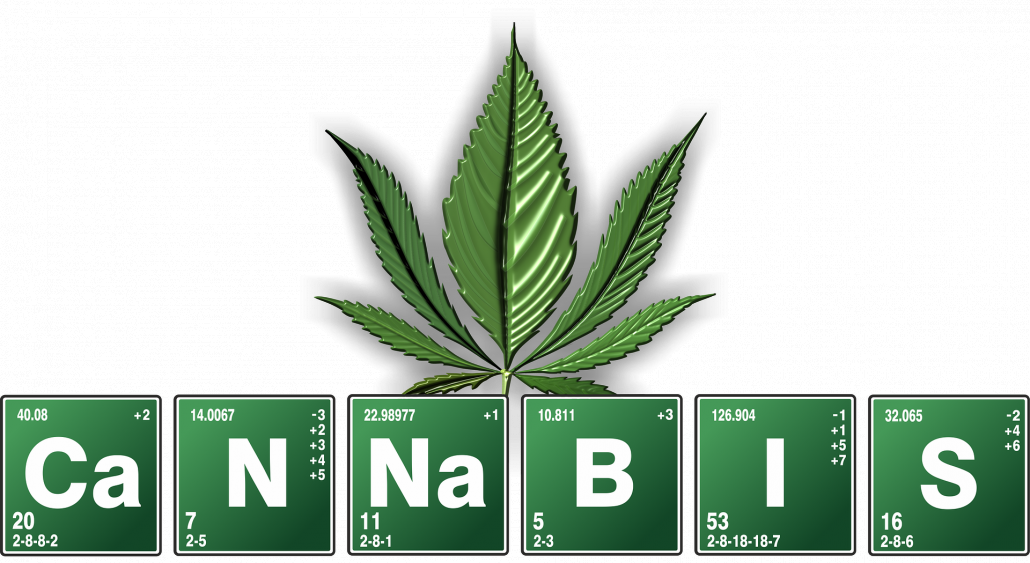
| "Cannabis” is the scientific name for the hemp plant, and its leaves and flowers (often called marijuana) contain hundreds of chemical substances, and over 100 of these are known as cannabinoids.
Cannabinoids affect cell receptors in the brain and body, as they contain a psychoactive resin that can affect how users feel, think and act.
|
|
|
|
THC is the most researched cannabinoid and is responsible for the way the brain and body respond to cannabis, including the high and intoxication. The potency of the THC in cannabis is often shown as a percentage of THC by weight, and has increased from an average of 3% in the 1980‘s to around 15% today, with some strains averaging as high as 30% THC. CBD is another cannabinoid, and is responsible for many of the plant's physical effects and has been used to treat anxiety, pain, inflammation, insomnia, nausea and epilepsy. Products will be labeled with THC and CBD percentages - the higher the percentage, the more potent the product.
There are two main cannabis species: cannabis sativa and cannabis indica. "Sativas" tend to have a more energizing and cerebral effect
when used recreationally, whereas "indicas" tend to have more sedative and physical effects. There are different strains of both plans, and hybrid plants that are genetic crosses of both.
Other slang terms for cannabis include: pot, bud, wax, erri, purp, keef, dope, honeycomb, herb, resin, trees, boom, weed, mary jane, ganja, skunk, shatter, budder, gangster, dank or dank krippy. These terms are different across cultures, communities and social groups and change continuously
|
| |
|
|
|
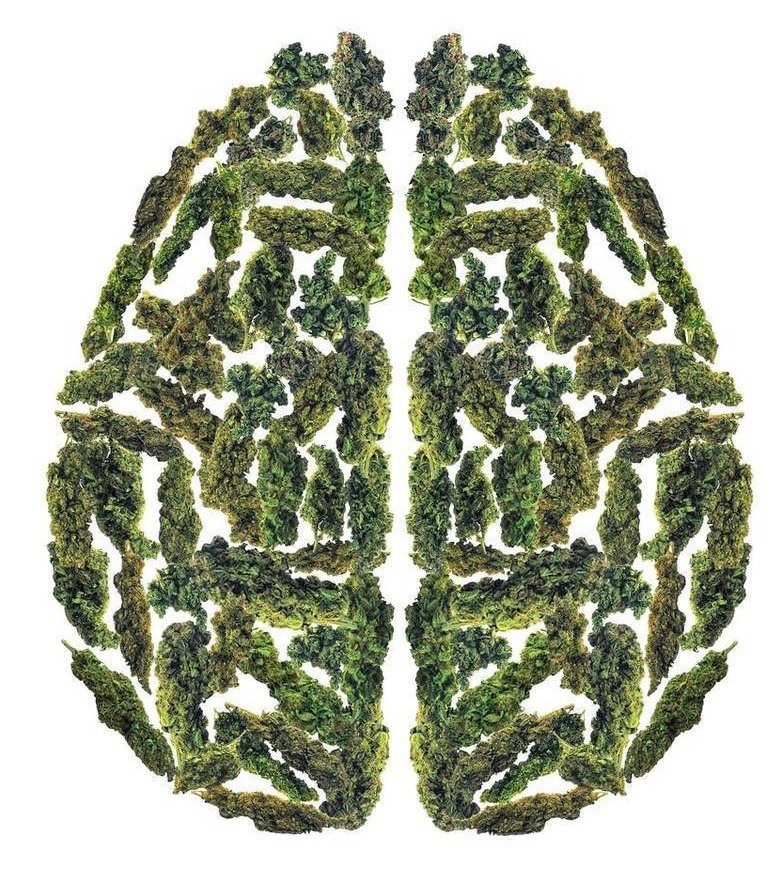 | Effects can be felt within seconds to minutes of smoking, vaporizing or dabbing marijuana. These effects can last up to 24 hours. By ingesting or drinking cannabis, effects can occur within 30 minutes to 2 hours and last up to 24 hours.
Cannabis can be both beneficial and harmful to health. For instance, research shows that cannabis can help relieve the symptoms of some medical conditions such as pain, nausea and muscle spasms. Use can also be associated with psychotic symptoms and respiratory issues.
|
|
|
Short term effects (often include): euphoria, sense of well-being, relaxation, heightened sensory experiences, confusion, sleepiness, impaired concentration, heightened anxiety.
Short term effects (may include): paranoia, delusions, hallucinations, increased heart rate, decreased blood pressure. |
Long term effects (develop gradually over time, with daily or weekly use that continues over weeks, months or years): increased risk of addiction, harm to memory, difficulties with concentration and ability to think and make decisions.
|
|
|
Early use in adolescence and frequency of use appears to worsen effects and may not be totally reversible.
|
|
|
HARM REDUCTION STRATEGIES FOR MARIJUANA USE
It is important to note, that while cannabis use for youth is currently illegal and will continue to be so, current research reflects that 1 in 5 teens aged 15 and 19 have used cannabis in the past year (Stats Canada 2016). Therefore, harm reduction strategies are an important element in discussions around cannabis use.
|
|
|
BEFORE USING: Be clear about why you want to use. What are the positive and negative potential consequences?
Be sure you trust your source. If it is an unregulated source, it is more likely to include contaminants like mold and mildew.
Try a small amount to test the strength. THC levels can vary greatly.
|
WHEN USING: Avoid cannabis smoke if possible. Cannabis smoke contains tar and toxins - it is safer to use a vaporizer.
Leave tobacco out of the mix, as tobacco contains many cancer causing toxins.
When eating or drinking cannabis, start with a small amount to guage concentration
|
WHAT TO AVOID: Using regularly before 25 years old (the human brain is not fully developed yet).
Using cannabis daily or almost daily (regular habitual use can lead to dependence).
Using cannabis with alcohol (effects of both are intensified, and judgment is increasingly compromised).
Using cannabis when you are at risk of a mental health concern (cannabis use may increase the risk of psychotic symptoms for those with a pre-existing vulnerability)
|
|
|
|
Canada's Lower-Risk Cannabis use Guidelines:
(Council of Chief Medical Officers of Health) 1. Cannabis use has health risks best avoided by abstaining.
2. Delay taking up cannabis use until later in life.
3. Identify and choose lower-risk cannabis products.
4. Don't use synthetic cannabinoids.
5. Avoid smoking burnt cannabis - choose safer ways of using.
6. If you smoke cannabis, avoid harmful smoking practices.
7. Limit and reduce how often you use cannabis.
8. Don't use and drive, or operate other machinery.
9. Avoid cannabis use altogether if you are at risk for mental health problems or pregnant.
10. Avoid combing these risks.
|
| |
|
|
|
|
|
|
|
The Greater Victoria School District is committed to providing safe and healthy learning environments for all students. As part of our approach, we have been focusing on mental health and substance use topics to help us promote well-being in our schools.
Substance use is a complex topic that often highlights varied philosophies, myths, and a great deal of fear. The research shows us that early interventions, particularly around critical thinking and decision making, has an impact on delaying use in youth. As well, open dialogue with adults, intentionality around attachment, and a focus on the
| factors that contribute to substance use, as opposed to the actual substances, also prevent, delay and reduce substance use in our students.
Our goal is to create a more cohesive, systematized substance use plan focusing on social emotional learning, that includes our youth and schools, community partners, and families. We strive for a shared vision, common language and consistent messaging over time, in order to support positive youth culture and a healthy perspective on substance use and mental health.
In B.C. the legal age for alcohol and cannabis consumption is 19 years old.
|
|
|
|
|
| |
|
|
|
|
|
|
|
|
| |
|